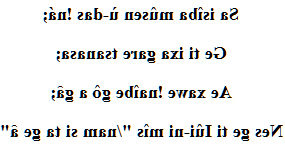Nama love poem
Mûnaixũs
Sa isîba mûsen ù-das !ná;
Ge ti ixa gare tsanasa;
Ae xawe !naîbe gô a gȃ;
Nes ge ti Iûi-ni mîs "nam si ta ge ȃ"

Other version
Mûnaixũs
Sa isiba mûsenxus !na;
Ge ti ixa gare tsanasa;
Xawe !naibe ga; nes ge ti
/nui-ni misa "/nam si ta a"

→ French poem ←
Khoekhoe a click language
Translation of my little love poem into Khoekhoegowab (Hottentot, Khoïkhoi, Nama, Khoekhoe, Khoi, Nasie, Maqua, Kakuya Bushman Nasie, Namagowab, Kakuya Bushman, Namaqua, Namakwa, Damara, Tamma, Sesfontein Damara, Gimsbok Nama, Khoekhoegowap, Central Damara, Dama, Namidama, Kupkaferrn, Damaqua, Tamakwa, Rooi Nasie, Naman, Berdama, Tama, Bergdamara, Kupkaffer).
This click language is one of the national languages of Namibia. It is a Khoi language of the Khoisan languages group. The clicking of click languages like this is considered as the oldest way of oral communication for humanity. My little poem was well worth a click, and I thank the two Namibians girls who lent themselves to the audio game. Click sounds are a characteristic of the Khoisan languages.
If clicks are used in many languages as interjections or indicators of disapproval, in the Khoikhoi language, there use is for ordinary sounds, equivalent in function to other consonants as constituent of words. The click is an ingressive occlusive consonant and whose emission is characterized by a double occlusion in the vocal tract.
The first occlusion is formed either by the lips (labial) or by the contact established between the tongue and the teeth or the palate; The second occlusion is realized by the elevation of the tongue towards the palate veil. The articulatory relaxation which succeeds the rarefaction of the air occurring between the two occlusions, generates a characteristic clicking noise. in the Khoisan languages, there are also the bilabial click, which is a kissing sound. The nama is the only language of the Khoisan group to have a written expression. There are about 200,000 speakers of Hottentot, more than twice that of any of the other Khoisan languages.
The Namas
The Hottentots or Khoi-Khois are an ethnic group of South Africa and South West, repressed or exterminated by the Bantu in the 18th. They are nomadic and live from breeding (beef, sheep, goat), hunting and picking. Organized in exogamous clans with patrilocal residence, they are governed by a council of clan authorities. The water so precious in their region plays an important part in the rites which chant the cults rendered to the creative god and to that of evil.
Namibia owes its name to the desert that borders its littoral fringe. Namibia has a dozen ethnic groups and a white minority of Germanic origin. The Damaras represent only 7.5% of its population. Contrary to appearances, although their very black skin, Dama or Damara do not belong to the Bantu, but to the Khoisan group. One finds them only in South West Africa. They call themselves !Nu-Khoin and the Namas call them Damans, two terms meaning black. Sometimes, the Namas also describe them as Chou-Daman, that mean: "dirty blacks".
Their origin is not well known but it's possible that they were brought as slaves by the Namas. The replacement of their own language with that of the Nama would argue in favor of this explanation. On the other hand, their knowledge of metals, which made them the first miners of the region, would encourage to think to an autonomous migration. The arrival of the Nama and the Herero, forced them to exile on the uplands. It was not until the arrival of the Europeans that they left them. The Namas are the Namibian branch of the Khoi, who were already wandering at the tip of Africa, when the whites accosted in the 15th century.
In the 18th and 19th centuries they emigrated to the other side of the Orange River (Gariep). They call them Khoi-Khoin, physically and linguistically they are like the Bushmen, but their social structure is more elaborate. Their mode of subsistence, breeding, pushed them to annihilate or enslave Bushmen and Dama who hunted their herds. At the arrival of the Bantu, they were themselves decimated.